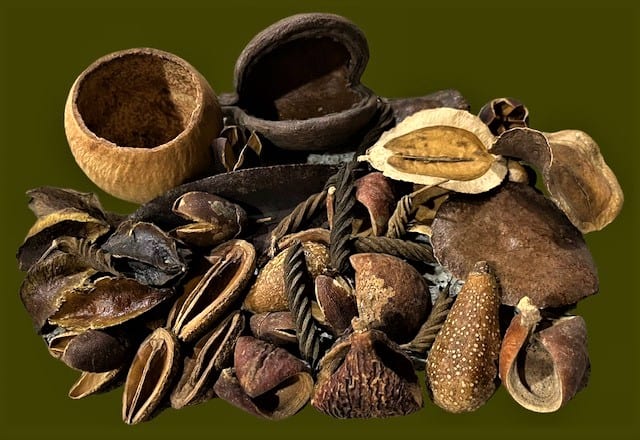Using botanicals in an aquarium can be a great way to enhance the natural look of your tank and create a more biologically diverse and stimulating environment for your aquatic pets. Here are some steps you can follow to use botanicals in your aquarium:
- Choose your botanicals: There are many different types of botanicals that can be used in an aquarium, including leaves, pods, cones, and woods. Some common botanicals include Indian Almond Leaves, Guava leaves, Alder Cones, Casuarina Cones, Sterculia pods, Twistie pods, Bakuli pods, etc. Consider the size of your aquarium and the type of fish or invertebrates you have when selecting your botanicals. Many are not only good for what they add to the water chemistry but are also excellent “hides” and can provide a food source for all fish fry and invertebrates.
- Prepare your botanicals: Before adding your botanicals to your aquarium, it is important to prepare them properly. Boiling or soaking your botanicals in water can help to remove any dirt or bacteria that may be present. If boiling them, we suggest 10-15 minutes. Some botanicals may also need to be soaked in water for a period of time prior to their sinking. Note: Tannins are a good thing but not always pleasing to the keeper’s eye so boiling and soaking them will help some leach out faster
- Rinse with clean water - We just use tap water but ifyou feel like it is safer for you then you can rinse in dechlorinated water.
- Add your botanicals: Once your botanicals are prepared, you can add them to your aquarium. It is best to place them strategically to create a natural-looking environment for your fish or invertebrates. Some botanicals can be attached to rocks or driftwood, while others can be placed directly on the substrate.
- Monitor your aquarium: After adding your botanicals to your aquarium, it is a good idea to monitor the water quality and the behavior of your fish or invertebrates. Some botanicals can affect the pH or hardness of your water, so it is important to test the water regularly and make adjustments as needed. You may also notice changes in the behavior of your aquatic pets as they explore and interact with the new environment.
- Do not overload your tank all at once. As with all things, take it a little at a time and observe. Adding too many at once may darken the water deeper than you like. If that is the case, remove some and do a partial water change. Do not toss out the ones removed. Simply just let them dry out and use them again later on
Overall, using botanicals in an aquarium can be a fun and rewarding way to create a more natural and stimulating environment for your fish or invertebrates. Just be sure to choose your botanicals carefully, prepare them properly, and monitor your aquarium regularly to ensure the health and well-being of your aquatic pets. Rest assured that all botanicals in stock at KJE are safe for your critters.
Next time you go to the lake, river, or your farm pond – Look in the water. What do you see? It is sticks, stones, leaves and cones.
Feel free to explore the huge variety of botanicals KJE Aquatics has to offer @ www.kjeaquatics.com


